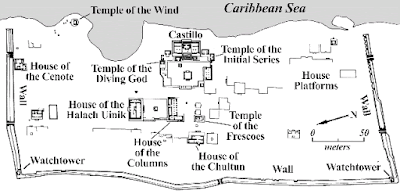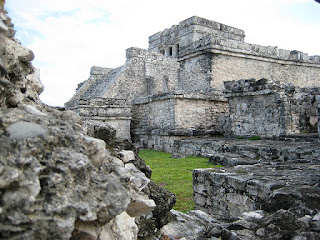As I prepare to embark on leading another group trip, I am looking forward to my surface interval adventure on the last day of our adventure before heading home.
Did you know in the state of Quintana Roo, Mexico, just a little over 80 miles south of the tourism metropolis of Cancun, you can step back into the ancient times of the magnificent Mayan world? Once a booming coastal port providing for the inland city of Cobá, Tulum still stands strong on a Yucatan coastal cliff above the aquamarine waters of the Caribbean Sea. A reflection of this once thriving city, the well-preserved ruins now stand as the perfect insight into the Mayan way of life from centuries ago.
Traveling Back in Time
Did you know in the state of Quintana Roo, Mexico, just a little over 80 miles south of the tourism metropolis of Cancun, you can step back into the ancient times of the magnificent Mayan world? Once a booming coastal port providing for the inland city of Cobá, Tulum still stands strong on a Yucatan coastal cliff above the aquamarine waters of the Caribbean Sea. A reflection of this once thriving city, the well-preserved ruins now stand as the perfect insight into the Mayan way of life from centuries ago.
Last of the Mayan Cities
an important part of the Mayan empire during the years of 1200-1530 AD. One of the last cities built and inhabited by the Maya, it is believed the original name of this port city was "Zama", meaning City of Dawn. The name was later changed to Tulum, the Yucatec word for "wall", "fence" or "fortification", most likely because of the defensible 26-foot thick, 9- to 16-foot high walls on the three land-bound sides of the city, with a 39-foot limestone cliff on the ocean side. Entrance to the city was via one of five tunnels through these formidable walls.
Tulum - Vibrant Hub of Trade
 |
| Tulum - One of the few Mayan cities built with a wall |
The Prominent Structures of Tulum
 |
| El Castillo - the castle |
 |
| Kukulcan - the Descending God |
Visiting the Ruins of Tulum
Being a relatively small archeological site, it is possible to experience Tulum in only a couple of hours, making it ideal to combine touring this site with another half-day excursion nearby like Xel Ha, Xcaret or Playa Del Carmen. Unlike Chichen Itza further inland, visitors may escape the heat by traversing the stairs to the beautiful beach below and taking a refreshing dip in the sea. That being said, don't forget to bring the basics - water, a hat, and sunscreen - with you to prevent dehydration and heat exhaustion, as temperatures in this area can get very warm during parts of the year. Also, remember to wear cool, breathable clothing, a comfortable pair of walking shoes, and insect repellent. And don't forget your camera and money for souvenirs. Even though it is one of the most visited Mayan ruins, Tulum is generally never over-crowded. And for you wildlife admirers and photographers, you will be happy to know iguanas and butterflies are often in abundance here.
So don't forget during your travels to the Yucatan Peninsula to take some time out during your vacation to escape to the past and visit this majestic reflection of Mayan society perfectly placed as the only Mayan ruin to be found along Mexico's Caribbean coastline..."Riviera Maya".
 Like what you've read? Want to learn how to better enjoy your scuba diving vacation? Maybe you'd like to travel with Delightful Departures on an upcoming adventure? Become part of the Delightful Departures community. Discover different destinations and travel tips in our biweekly newsletter. Join today.
Like what you've read? Want to learn how to better enjoy your scuba diving vacation? Maybe you'd like to travel with Delightful Departures on an upcoming adventure? Become part of the Delightful Departures community. Discover different destinations and travel tips in our biweekly newsletter. Join today.
 Like what you've read? Want to learn how to better enjoy your scuba diving vacation? Maybe you'd like to travel with Delightful Departures on an upcoming adventure? Become part of the Delightful Departures community. Discover different destinations and travel tips in our biweekly newsletter. Join today.
Like what you've read? Want to learn how to better enjoy your scuba diving vacation? Maybe you'd like to travel with Delightful Departures on an upcoming adventure? Become part of the Delightful Departures community. Discover different destinations and travel tips in our biweekly newsletter. Join today.





No comments:
Post a Comment